BM627: Innovation Audit and Business Strategy of Renault Clio
VerifiedAdded on 2023/04/07
|32
|4064
|476
Report
AI Summary
This report provides an in-depth innovation audit of Renault Clio, a product of the French multinational automobile manufacturer Renault. It begins with an overview of the automotive industry and Renault's background, followed by tracing the innovation history of the Renault Clio using the 4P's innovation space model (Product, Place, Process, Paradigm). The report analyzes whether Renault's innovation strategy follows a radical or incremental approach. Furthermore, it examines the impact of PESTEL factors (Political, Economic, Social, Technological, Environmental, and Legal) and Porter's Five Forces on Renault Clio's business environment. A SWOT analysis is conducted to assess the strengths, weaknesses, opportunities, and threats, and a value chain analysis is performed to investigate the company's performance capabilities. The report concludes with a discussion of Renault's vision for 2019 and beyond, highlighting the company's 28 years of success and its future prospects in the automotive industry. This document is available on Desklib, a platform offering a wide array of study tools and resources for students.
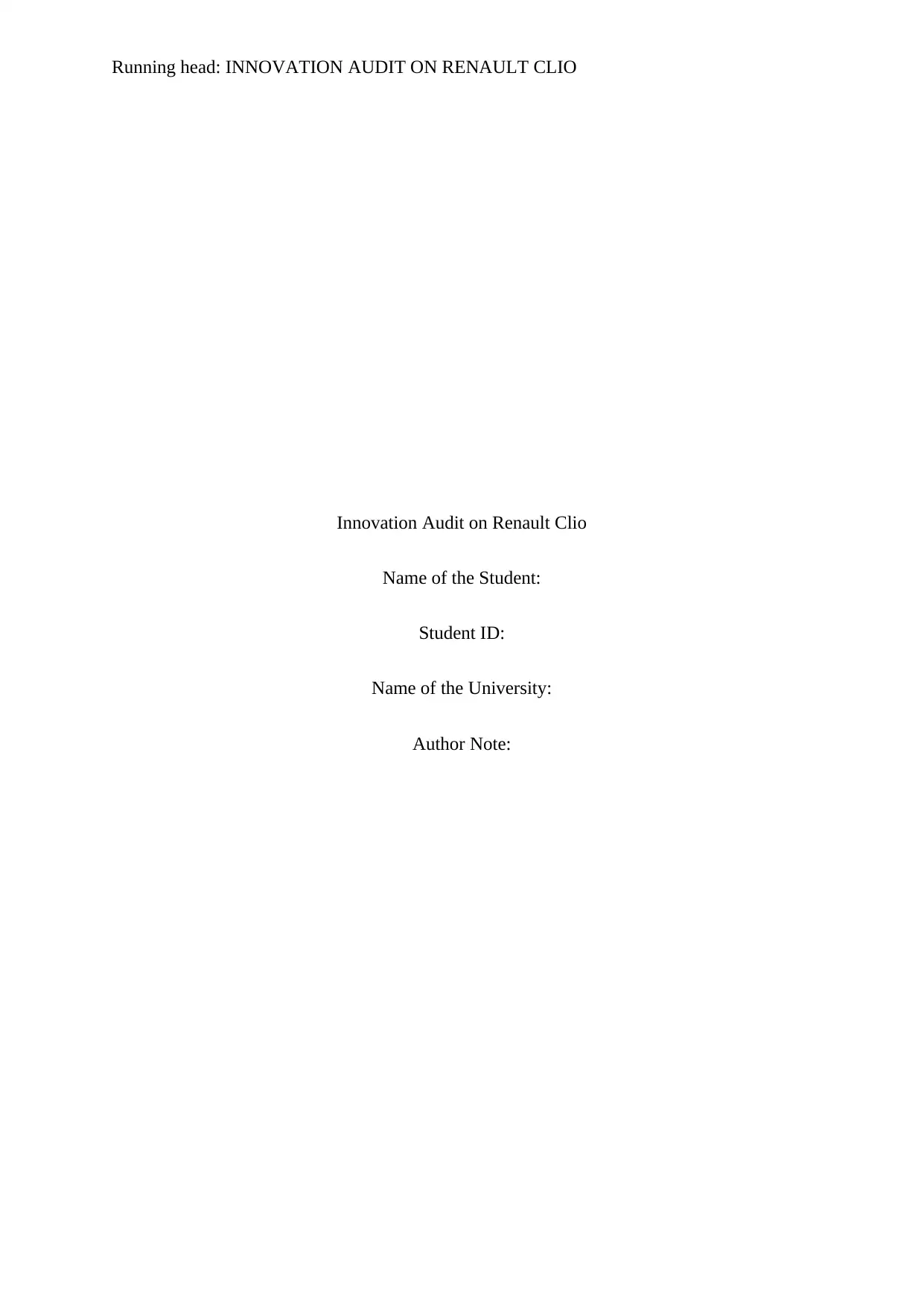
Running head: INNOVATION AUDIT ON RENAULT CLIO
Innovation Audit on Renault Clio
Name of the Student:
Student ID:
Name of the University:
Author Note:
Innovation Audit on Renault Clio
Name of the Student:
Student ID:
Name of the University:
Author Note:
Paraphrase This Document
Need a fresh take? Get an instant paraphrase of this document with our AI Paraphraser
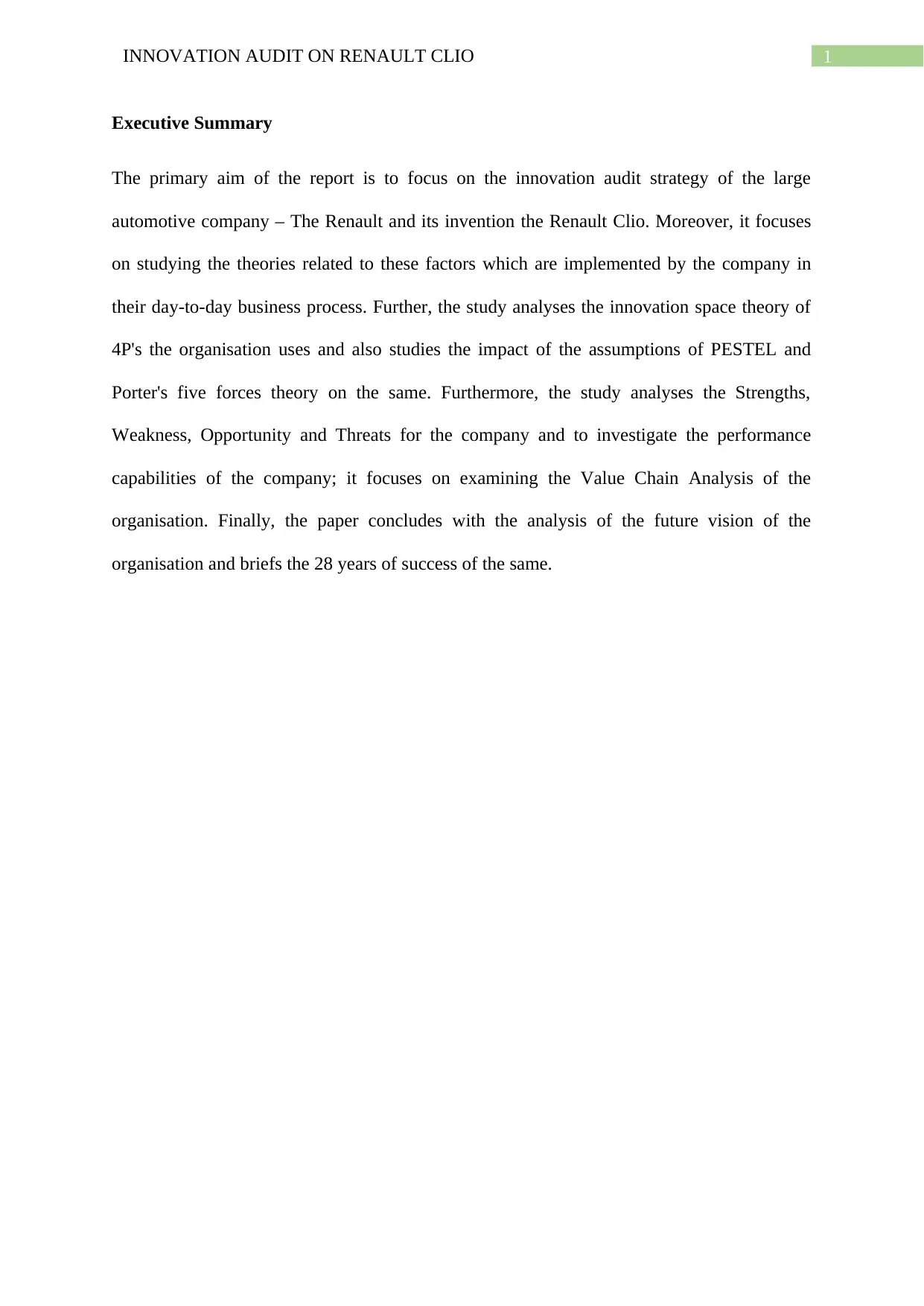
1INNOVATION AUDIT ON RENAULT CLIO
Executive Summary
The primary aim of the report is to focus on the innovation audit strategy of the large
automotive company – The Renault and its invention the Renault Clio. Moreover, it focuses
on studying the theories related to these factors which are implemented by the company in
their day-to-day business process. Further, the study analyses the innovation space theory of
4P's the organisation uses and also studies the impact of the assumptions of PESTEL and
Porter's five forces theory on the same. Furthermore, the study analyses the Strengths,
Weakness, Opportunity and Threats for the company and to investigate the performance
capabilities of the company; it focuses on examining the Value Chain Analysis of the
organisation. Finally, the paper concludes with the analysis of the future vision of the
organisation and briefs the 28 years of success of the same.
Executive Summary
The primary aim of the report is to focus on the innovation audit strategy of the large
automotive company – The Renault and its invention the Renault Clio. Moreover, it focuses
on studying the theories related to these factors which are implemented by the company in
their day-to-day business process. Further, the study analyses the innovation space theory of
4P's the organisation uses and also studies the impact of the assumptions of PESTEL and
Porter's five forces theory on the same. Furthermore, the study analyses the Strengths,
Weakness, Opportunity and Threats for the company and to investigate the performance
capabilities of the company; it focuses on examining the Value Chain Analysis of the
organisation. Finally, the paper concludes with the analysis of the future vision of the
organisation and briefs the 28 years of success of the same.
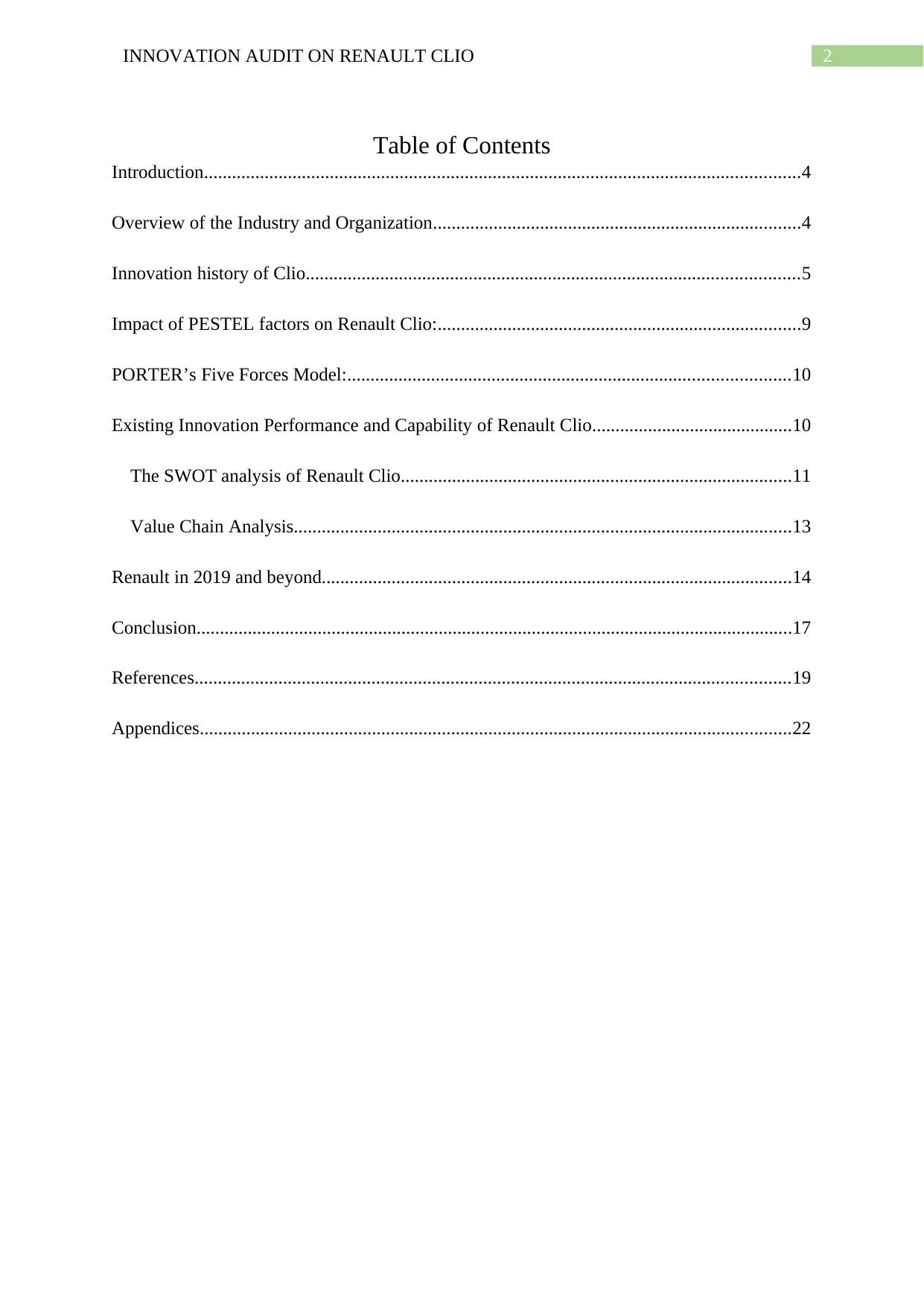
2INNOVATION AUDIT ON RENAULT CLIO
Table of Contents
Introduction................................................................................................................................4
Overview of the Industry and Organization...............................................................................4
Innovation history of Clio..........................................................................................................5
Impact of PESTEL factors on Renault Clio:..............................................................................9
PORTER’s Five Forces Model:...............................................................................................10
Existing Innovation Performance and Capability of Renault Clio...........................................10
The SWOT analysis of Renault Clio....................................................................................11
Value Chain Analysis...........................................................................................................13
Renault in 2019 and beyond.....................................................................................................14
Conclusion................................................................................................................................17
References................................................................................................................................19
Appendices...............................................................................................................................22
Table of Contents
Introduction................................................................................................................................4
Overview of the Industry and Organization...............................................................................4
Innovation history of Clio..........................................................................................................5
Impact of PESTEL factors on Renault Clio:..............................................................................9
PORTER’s Five Forces Model:...............................................................................................10
Existing Innovation Performance and Capability of Renault Clio...........................................10
The SWOT analysis of Renault Clio....................................................................................11
Value Chain Analysis...........................................................................................................13
Renault in 2019 and beyond.....................................................................................................14
Conclusion................................................................................................................................17
References................................................................................................................................19
Appendices...............................................................................................................................22
⊘ This is a preview!⊘
Do you want full access?
Subscribe today to unlock all pages.

Trusted by 1+ million students worldwide
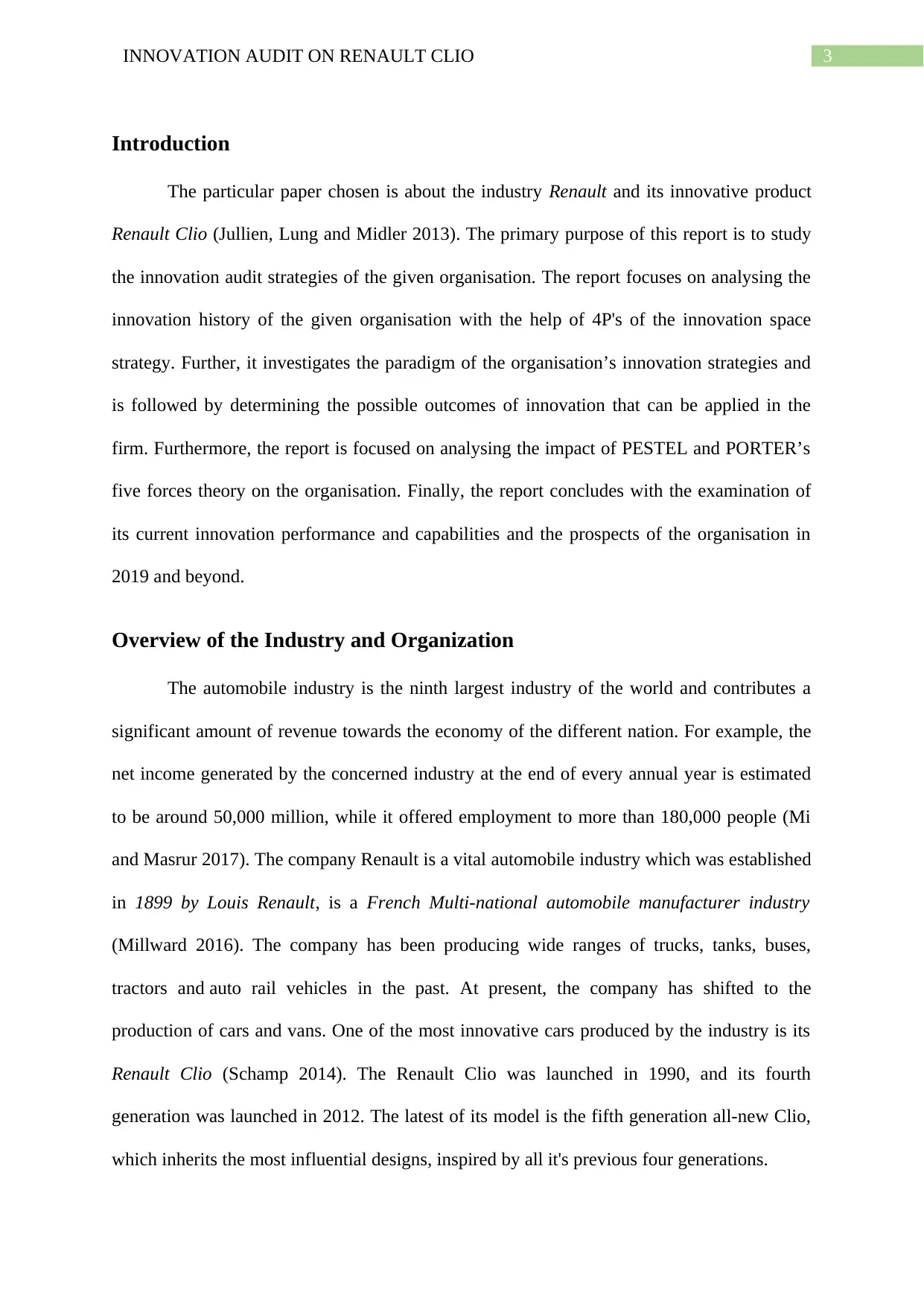
3INNOVATION AUDIT ON RENAULT CLIO
Introduction
The particular paper chosen is about the industry Renault and its innovative product
Renault Clio (Jullien, Lung and Midler 2013). The primary purpose of this report is to study
the innovation audit strategies of the given organisation. The report focuses on analysing the
innovation history of the given organisation with the help of 4P's of the innovation space
strategy. Further, it investigates the paradigm of the organisation’s innovation strategies and
is followed by determining the possible outcomes of innovation that can be applied in the
firm. Furthermore, the report is focused on analysing the impact of PESTEL and PORTER’s
five forces theory on the organisation. Finally, the report concludes with the examination of
its current innovation performance and capabilities and the prospects of the organisation in
2019 and beyond.
Overview of the Industry and Organization
The automobile industry is the ninth largest industry of the world and contributes a
significant amount of revenue towards the economy of the different nation. For example, the
net income generated by the concerned industry at the end of every annual year is estimated
to be around 50,000 million, while it offered employment to more than 180,000 people (Mi
and Masrur 2017). The company Renault is a vital automobile industry which was established
in 1899 by Louis Renault, is a French Multi-national automobile manufacturer industry
(Millward 2016). The company has been producing wide ranges of trucks, tanks, buses,
tractors and auto rail vehicles in the past. At present, the company has shifted to the
production of cars and vans. One of the most innovative cars produced by the industry is its
Renault Clio (Schamp 2014). The Renault Clio was launched in 1990, and its fourth
generation was launched in 2012. The latest of its model is the fifth generation all-new Clio,
which inherits the most influential designs, inspired by all it's previous four generations.
Introduction
The particular paper chosen is about the industry Renault and its innovative product
Renault Clio (Jullien, Lung and Midler 2013). The primary purpose of this report is to study
the innovation audit strategies of the given organisation. The report focuses on analysing the
innovation history of the given organisation with the help of 4P's of the innovation space
strategy. Further, it investigates the paradigm of the organisation’s innovation strategies and
is followed by determining the possible outcomes of innovation that can be applied in the
firm. Furthermore, the report is focused on analysing the impact of PESTEL and PORTER’s
five forces theory on the organisation. Finally, the report concludes with the examination of
its current innovation performance and capabilities and the prospects of the organisation in
2019 and beyond.
Overview of the Industry and Organization
The automobile industry is the ninth largest industry of the world and contributes a
significant amount of revenue towards the economy of the different nation. For example, the
net income generated by the concerned industry at the end of every annual year is estimated
to be around 50,000 million, while it offered employment to more than 180,000 people (Mi
and Masrur 2017). The company Renault is a vital automobile industry which was established
in 1899 by Louis Renault, is a French Multi-national automobile manufacturer industry
(Millward 2016). The company has been producing wide ranges of trucks, tanks, buses,
tractors and auto rail vehicles in the past. At present, the company has shifted to the
production of cars and vans. One of the most innovative cars produced by the industry is its
Renault Clio (Schamp 2014). The Renault Clio was launched in 1990, and its fourth
generation was launched in 2012. The latest of its model is the fifth generation all-new Clio,
which inherits the most influential designs, inspired by all it's previous four generations.
Paraphrase This Document
Need a fresh take? Get an instant paraphrase of this document with our AI Paraphraser
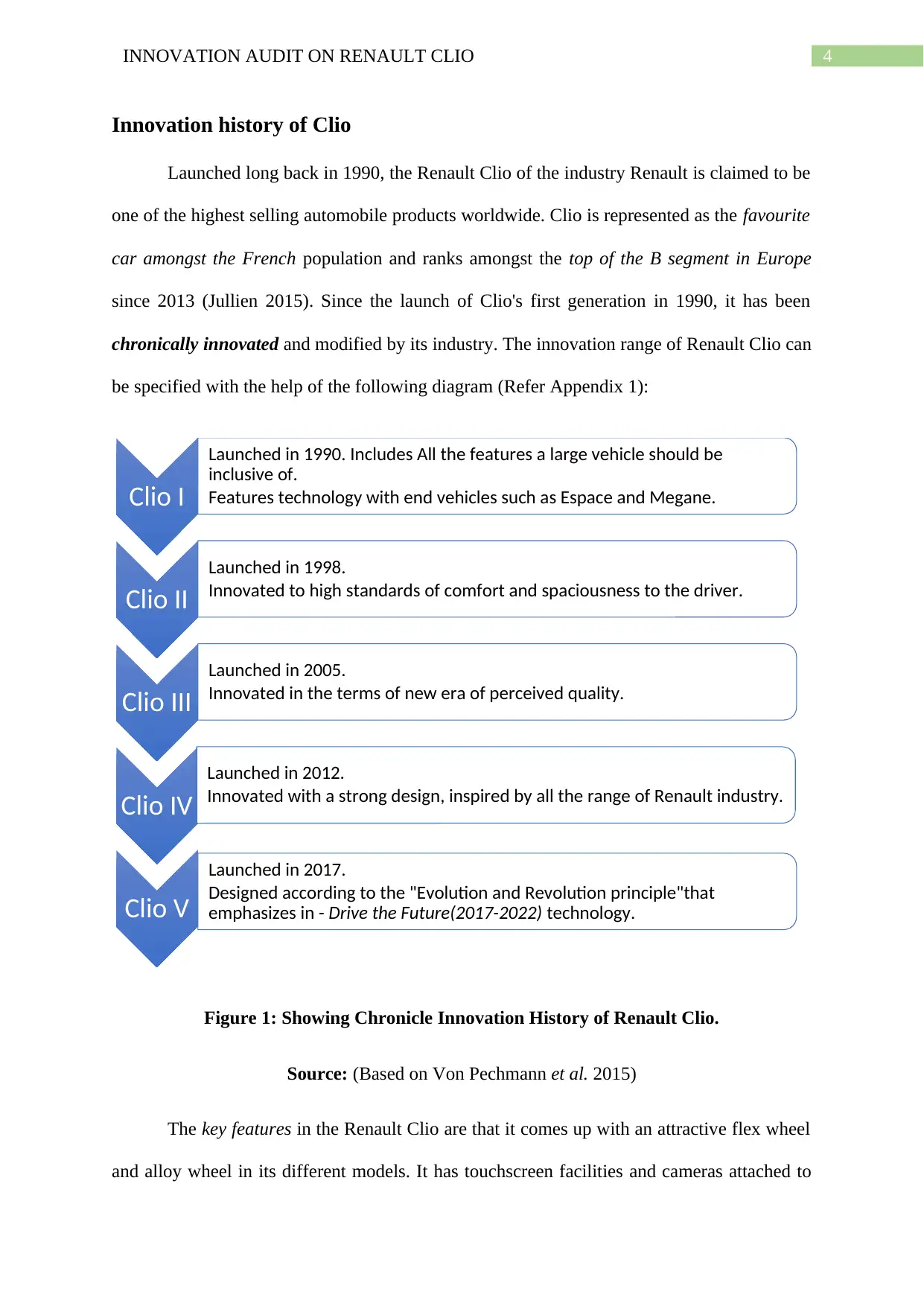
4INNOVATION AUDIT ON RENAULT CLIO
Innovation history of Clio
Launched long back in 1990, the Renault Clio of the industry Renault is claimed to be
one of the highest selling automobile products worldwide. Clio is represented as the favourite
car amongst the French population and ranks amongst the top of the B segment in Europe
since 2013 (Jullien 2015). Since the launch of Clio's first generation in 1990, it has been
chronically innovated and modified by its industry. The innovation range of Renault Clio can
be specified with the help of the following diagram (Refer Appendix 1):
Figure 1: Showing Chronicle Innovation History of Renault Clio.
Source: (Based on Von Pechmann et al. 2015)
The key features in the Renault Clio are that it comes up with an attractive flex wheel
and alloy wheel in its different models. It has touchscreen facilities and cameras attached to
Clio I
Launched in 1990. Includes All the features a large vehicle should be
inclusive of.
Features technology with end vehicles such as Espace and Megane.
Clio II
Launched in 1998.
Innovated to high standards of comfort and spaciousness to the driver.
Clio III
Launched in 2005.
Innovated in the terms of new era of perceived quality.
Clio IV
Launched in 2012.
Innovated with a strong design, inspired by all the range of Renault industry.
Clio V
Launched in 2017.
Designed according to the "Evolution and Revolution principle"that
emphasizes in - Drive the Future(2017-2022) technology.
Innovation history of Clio
Launched long back in 1990, the Renault Clio of the industry Renault is claimed to be
one of the highest selling automobile products worldwide. Clio is represented as the favourite
car amongst the French population and ranks amongst the top of the B segment in Europe
since 2013 (Jullien 2015). Since the launch of Clio's first generation in 1990, it has been
chronically innovated and modified by its industry. The innovation range of Renault Clio can
be specified with the help of the following diagram (Refer Appendix 1):
Figure 1: Showing Chronicle Innovation History of Renault Clio.
Source: (Based on Von Pechmann et al. 2015)
The key features in the Renault Clio are that it comes up with an attractive flex wheel
and alloy wheel in its different models. It has touchscreen facilities and cameras attached to
Clio I
Launched in 1990. Includes All the features a large vehicle should be
inclusive of.
Features technology with end vehicles such as Espace and Megane.
Clio II
Launched in 1998.
Innovated to high standards of comfort and spaciousness to the driver.
Clio III
Launched in 2005.
Innovated in the terms of new era of perceived quality.
Clio IV
Launched in 2012.
Innovated with a strong design, inspired by all the range of Renault industry.
Clio V
Launched in 2017.
Designed according to the "Evolution and Revolution principle"that
emphasizes in - Drive the Future(2017-2022) technology.
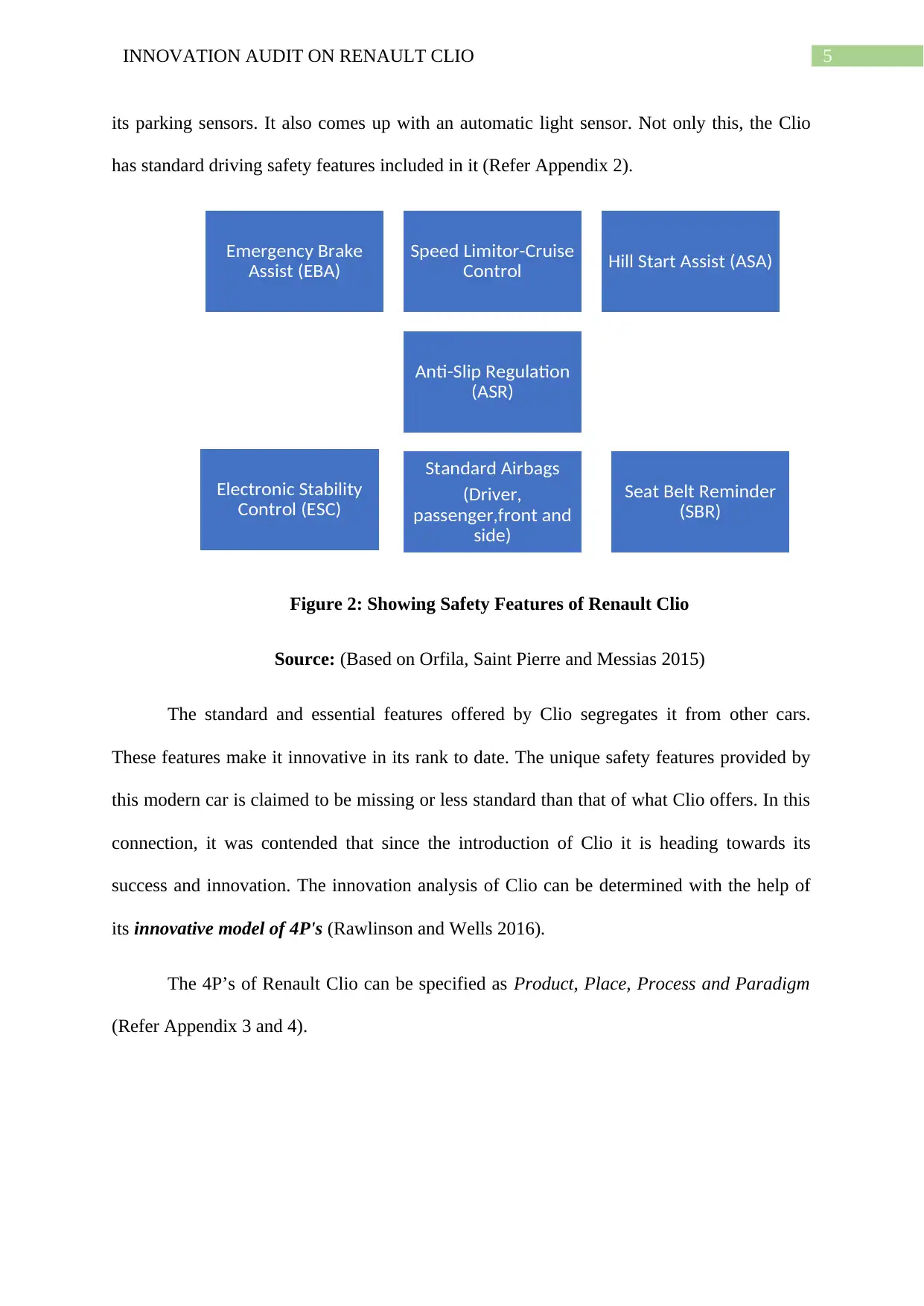
5INNOVATION AUDIT ON RENAULT CLIO
its parking sensors. It also comes up with an automatic light sensor. Not only this, the Clio
has standard driving safety features included in it (Refer Appendix 2).
Figure 2: Showing Safety Features of Renault Clio
Source: (Based on Orfila, Saint Pierre and Messias 2015)
The standard and essential features offered by Clio segregates it from other cars.
These features make it innovative in its rank to date. The unique safety features provided by
this modern car is claimed to be missing or less standard than that of what Clio offers. In this
connection, it was contended that since the introduction of Clio it is heading towards its
success and innovation. The innovation analysis of Clio can be determined with the help of
its innovative model of 4P's (Rawlinson and Wells 2016).
The 4P’s of Renault Clio can be specified as Product, Place, Process and Paradigm
(Refer Appendix 3 and 4).
Emergency Brake
Assist (EBA)
Speed Limitor-Cruise
Control Hill Start Assist (ASA)
Electronic Stability
Control (ESC)
Anti-Slip Regulation
(ASR)
Seat Belt Reminder
(SBR)
Standard Airbags
(Driver,
passenger,front and
side)
its parking sensors. It also comes up with an automatic light sensor. Not only this, the Clio
has standard driving safety features included in it (Refer Appendix 2).
Figure 2: Showing Safety Features of Renault Clio
Source: (Based on Orfila, Saint Pierre and Messias 2015)
The standard and essential features offered by Clio segregates it from other cars.
These features make it innovative in its rank to date. The unique safety features provided by
this modern car is claimed to be missing or less standard than that of what Clio offers. In this
connection, it was contended that since the introduction of Clio it is heading towards its
success and innovation. The innovation analysis of Clio can be determined with the help of
its innovative model of 4P's (Rawlinson and Wells 2016).
The 4P’s of Renault Clio can be specified as Product, Place, Process and Paradigm
(Refer Appendix 3 and 4).
Emergency Brake
Assist (EBA)
Speed Limitor-Cruise
Control Hill Start Assist (ASA)
Electronic Stability
Control (ESC)
Anti-Slip Regulation
(ASR)
Seat Belt Reminder
(SBR)
Standard Airbags
(Driver,
passenger,front and
side)
⊘ This is a preview!⊘
Do you want full access?
Subscribe today to unlock all pages.

Trusted by 1+ million students worldwide
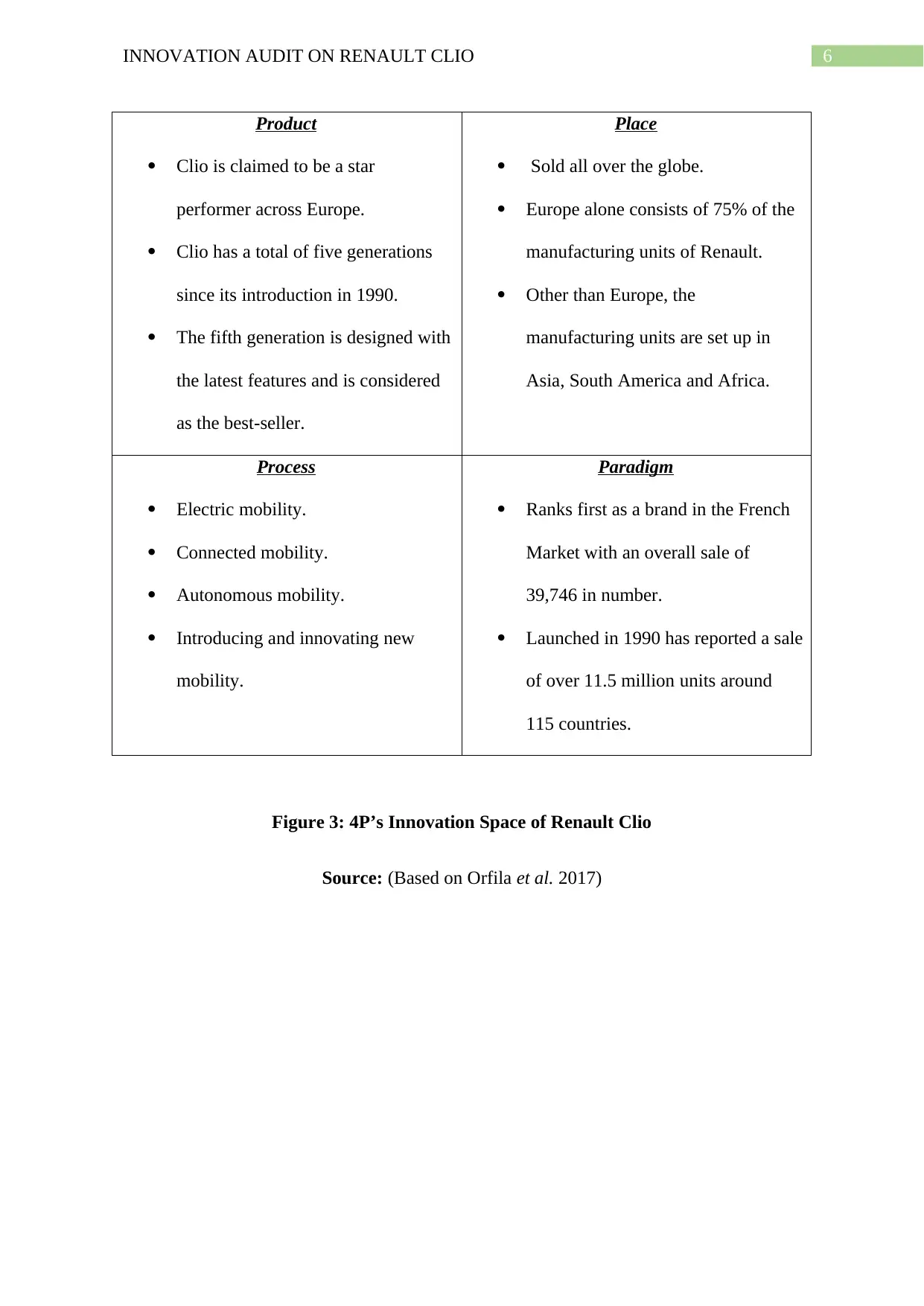
6INNOVATION AUDIT ON RENAULT CLIO
Product
Clio is claimed to be a star
performer across Europe.
Clio has a total of five generations
since its introduction in 1990.
The fifth generation is designed with
the latest features and is considered
as the best-seller.
Place
Sold all over the globe.
Europe alone consists of 75% of the
manufacturing units of Renault.
Other than Europe, the
manufacturing units are set up in
Asia, South America and Africa.
Process
Electric mobility.
Connected mobility.
Autonomous mobility.
Introducing and innovating new
mobility.
Paradigm
Ranks first as a brand in the French
Market with an overall sale of
39,746 in number.
Launched in 1990 has reported a sale
of over 11.5 million units around
115 countries.
Figure 3: 4P’s Innovation Space of Renault Clio
Source: (Based on Orfila et al. 2017)
Product
Clio is claimed to be a star
performer across Europe.
Clio has a total of five generations
since its introduction in 1990.
The fifth generation is designed with
the latest features and is considered
as the best-seller.
Place
Sold all over the globe.
Europe alone consists of 75% of the
manufacturing units of Renault.
Other than Europe, the
manufacturing units are set up in
Asia, South America and Africa.
Process
Electric mobility.
Connected mobility.
Autonomous mobility.
Introducing and innovating new
mobility.
Paradigm
Ranks first as a brand in the French
Market with an overall sale of
39,746 in number.
Launched in 1990 has reported a sale
of over 11.5 million units around
115 countries.
Figure 3: 4P’s Innovation Space of Renault Clio
Source: (Based on Orfila et al. 2017)
Paraphrase This Document
Need a fresh take? Get an instant paraphrase of this document with our AI Paraphraser
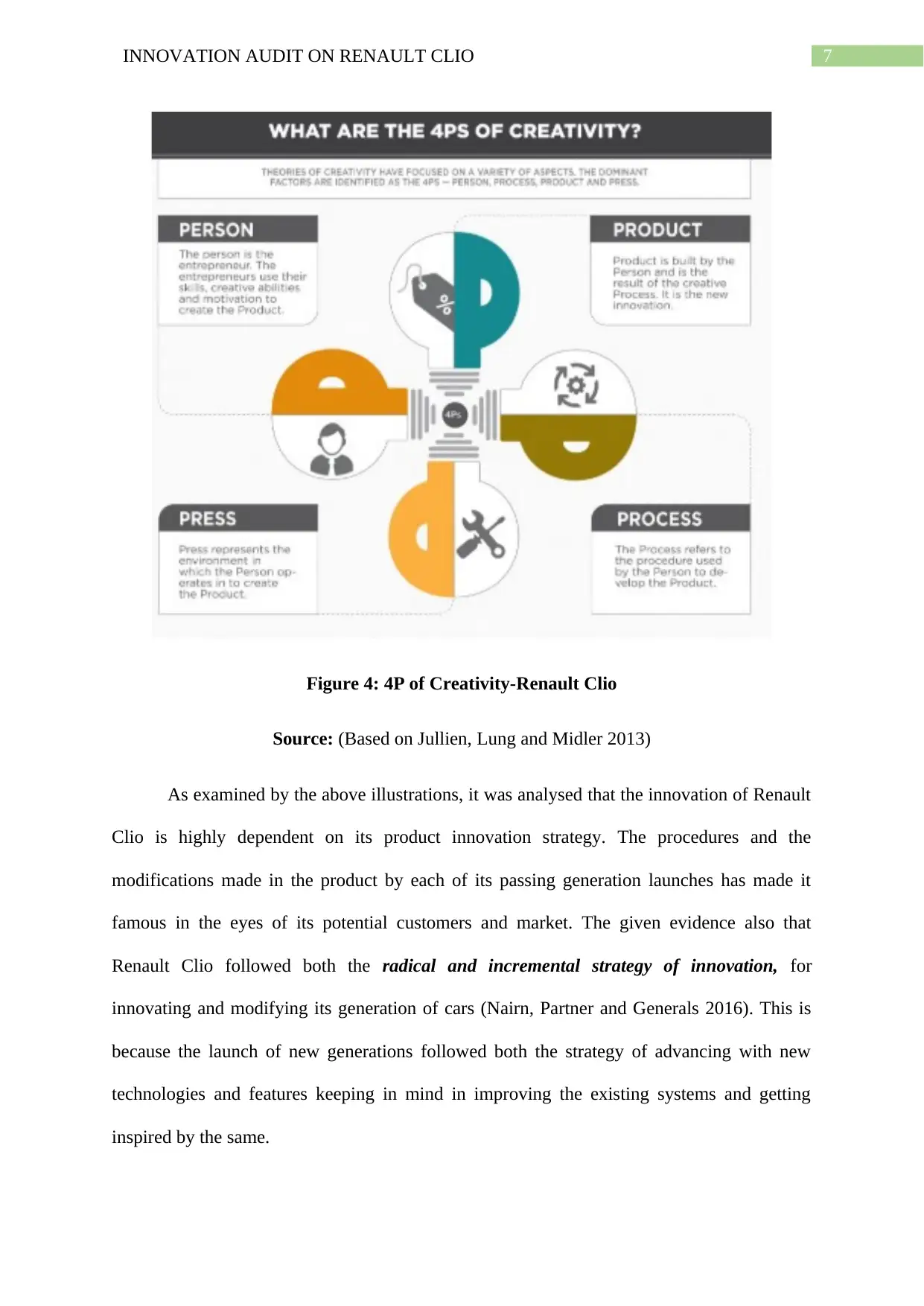
7INNOVATION AUDIT ON RENAULT CLIO
Figure 4: 4P of Creativity-Renault Clio
Source: (Based on Jullien, Lung and Midler 2013)
As examined by the above illustrations, it was analysed that the innovation of Renault
Clio is highly dependent on its product innovation strategy. The procedures and the
modifications made in the product by each of its passing generation launches has made it
famous in the eyes of its potential customers and market. The given evidence also that
Renault Clio followed both the radical and incremental strategy of innovation, for
innovating and modifying its generation of cars (Nairn, Partner and Generals 2016). This is
because the launch of new generations followed both the strategy of advancing with new
technologies and features keeping in mind in improving the existing systems and getting
inspired by the same.
Figure 4: 4P of Creativity-Renault Clio
Source: (Based on Jullien, Lung and Midler 2013)
As examined by the above illustrations, it was analysed that the innovation of Renault
Clio is highly dependent on its product innovation strategy. The procedures and the
modifications made in the product by each of its passing generation launches has made it
famous in the eyes of its potential customers and market. The given evidence also that
Renault Clio followed both the radical and incremental strategy of innovation, for
innovating and modifying its generation of cars (Nairn, Partner and Generals 2016). This is
because the launch of new generations followed both the strategy of advancing with new
technologies and features keeping in mind in improving the existing systems and getting
inspired by the same.
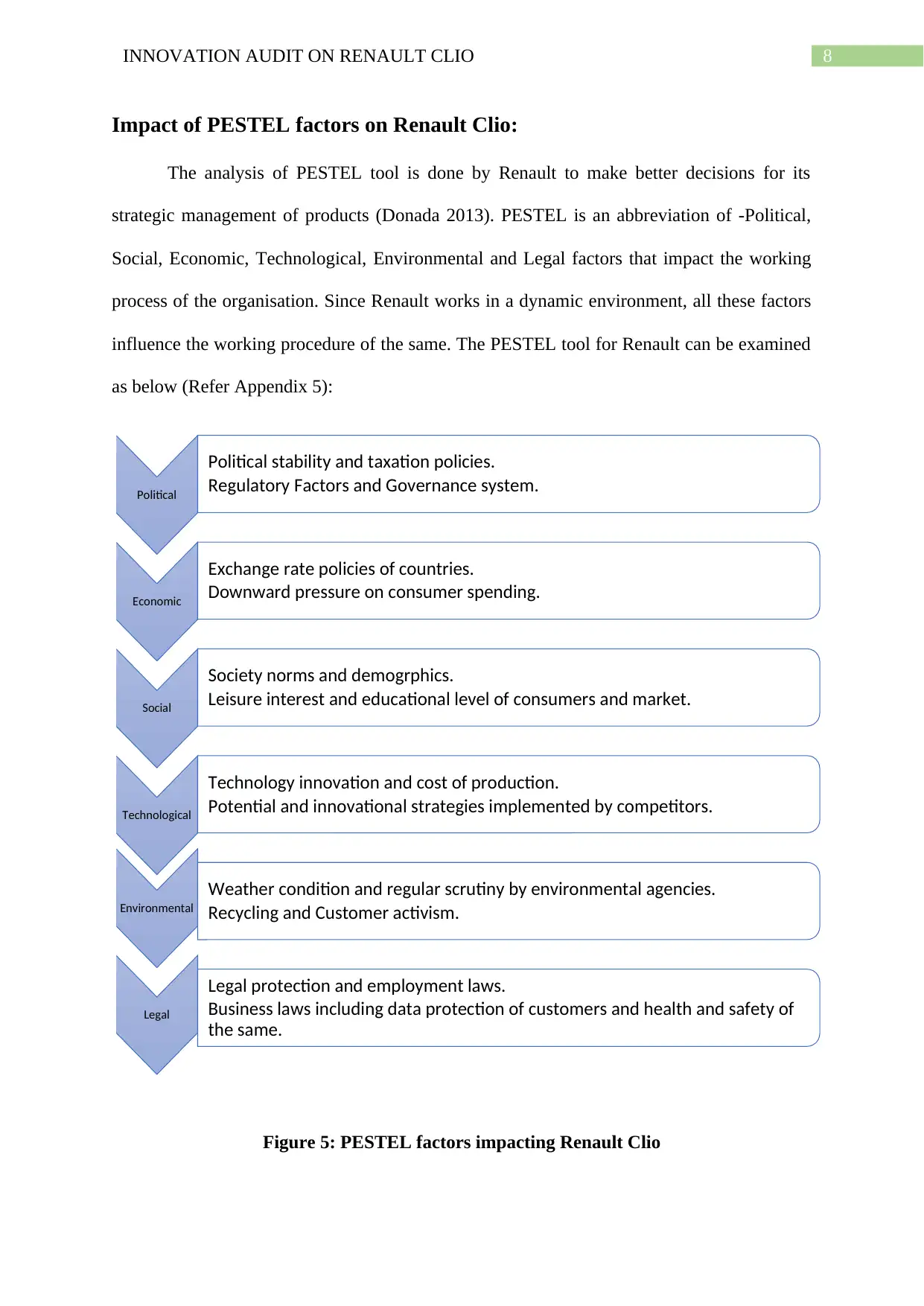
8INNOVATION AUDIT ON RENAULT CLIO
Impact of PESTEL factors on Renault Clio:
The analysis of PESTEL tool is done by Renault to make better decisions for its
strategic management of products (Donada 2013). PESTEL is an abbreviation of -Political,
Social, Economic, Technological, Environmental and Legal factors that impact the working
process of the organisation. Since Renault works in a dynamic environment, all these factors
influence the working procedure of the same. The PESTEL tool for Renault can be examined
as below (Refer Appendix 5):
Figure 5: PESTEL factors impacting Renault Clio
Political
Political stability and taxation policies.
Regulatory Factors and Governance system.
Economic
Exchange rate policies of countries.
Downward pressure on consumer spending.
Social
Society norms and demogrphics.
Leisure interest and educational level of consumers and market.
Technological
Technology innovation and cost of production.
Potential and innovational strategies implemented by competitors.
Environmental
Weather condition and regular scrutiny by environmental agencies.
Recycling and Customer activism.
Legal
Legal protection and employment laws.
Business laws including data protection of customers and health and safety of
the same.
Impact of PESTEL factors on Renault Clio:
The analysis of PESTEL tool is done by Renault to make better decisions for its
strategic management of products (Donada 2013). PESTEL is an abbreviation of -Political,
Social, Economic, Technological, Environmental and Legal factors that impact the working
process of the organisation. Since Renault works in a dynamic environment, all these factors
influence the working procedure of the same. The PESTEL tool for Renault can be examined
as below (Refer Appendix 5):
Figure 5: PESTEL factors impacting Renault Clio
Political
Political stability and taxation policies.
Regulatory Factors and Governance system.
Economic
Exchange rate policies of countries.
Downward pressure on consumer spending.
Social
Society norms and demogrphics.
Leisure interest and educational level of consumers and market.
Technological
Technology innovation and cost of production.
Potential and innovational strategies implemented by competitors.
Environmental
Weather condition and regular scrutiny by environmental agencies.
Recycling and Customer activism.
Legal
Legal protection and employment laws.
Business laws including data protection of customers and health and safety of
the same.
⊘ This is a preview!⊘
Do you want full access?
Subscribe today to unlock all pages.

Trusted by 1+ million students worldwide
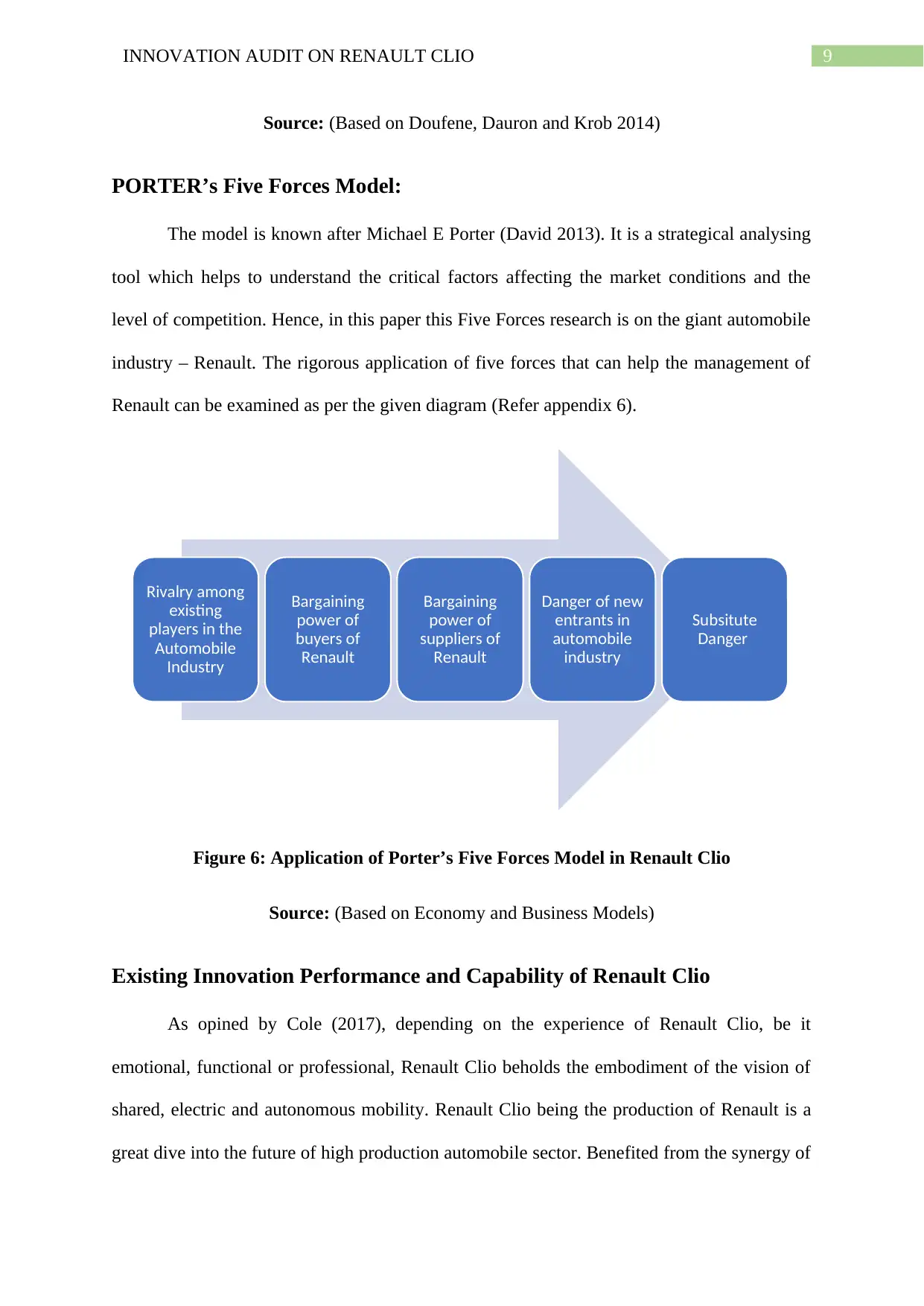
9INNOVATION AUDIT ON RENAULT CLIO
Source: (Based on Doufene, Dauron and Krob 2014)
PORTER’s Five Forces Model:
The model is known after Michael E Porter (David 2013). It is a strategical analysing
tool which helps to understand the critical factors affecting the market conditions and the
level of competition. Hence, in this paper this Five Forces research is on the giant automobile
industry – Renault. The rigorous application of five forces that can help the management of
Renault can be examined as per the given diagram (Refer appendix 6).
Figure 6: Application of Porter’s Five Forces Model in Renault Clio
Source: (Based on Economy and Business Models)
Existing Innovation Performance and Capability of Renault Clio
As opined by Cole (2017), depending on the experience of Renault Clio, be it
emotional, functional or professional, Renault Clio beholds the embodiment of the vision of
shared, electric and autonomous mobility. Renault Clio being the production of Renault is a
great dive into the future of high production automobile sector. Benefited from the synergy of
Rivalry among
existing
players in the
Automobile
Industry
Bargaining
power of
buyers of
Renault
Bargaining
power of
suppliers of
Renault
Danger of new
entrants in
automobile
industry
Subsitute
Danger
Source: (Based on Doufene, Dauron and Krob 2014)
PORTER’s Five Forces Model:
The model is known after Michael E Porter (David 2013). It is a strategical analysing
tool which helps to understand the critical factors affecting the market conditions and the
level of competition. Hence, in this paper this Five Forces research is on the giant automobile
industry – Renault. The rigorous application of five forces that can help the management of
Renault can be examined as per the given diagram (Refer appendix 6).
Figure 6: Application of Porter’s Five Forces Model in Renault Clio
Source: (Based on Economy and Business Models)
Existing Innovation Performance and Capability of Renault Clio
As opined by Cole (2017), depending on the experience of Renault Clio, be it
emotional, functional or professional, Renault Clio beholds the embodiment of the vision of
shared, electric and autonomous mobility. Renault Clio being the production of Renault is a
great dive into the future of high production automobile sector. Benefited from the synergy of
Rivalry among
existing
players in the
Automobile
Industry
Bargaining
power of
buyers of
Renault
Bargaining
power of
suppliers of
Renault
Danger of new
entrants in
automobile
industry
Subsitute
Danger
Paraphrase This Document
Need a fresh take? Get an instant paraphrase of this document with our AI Paraphraser
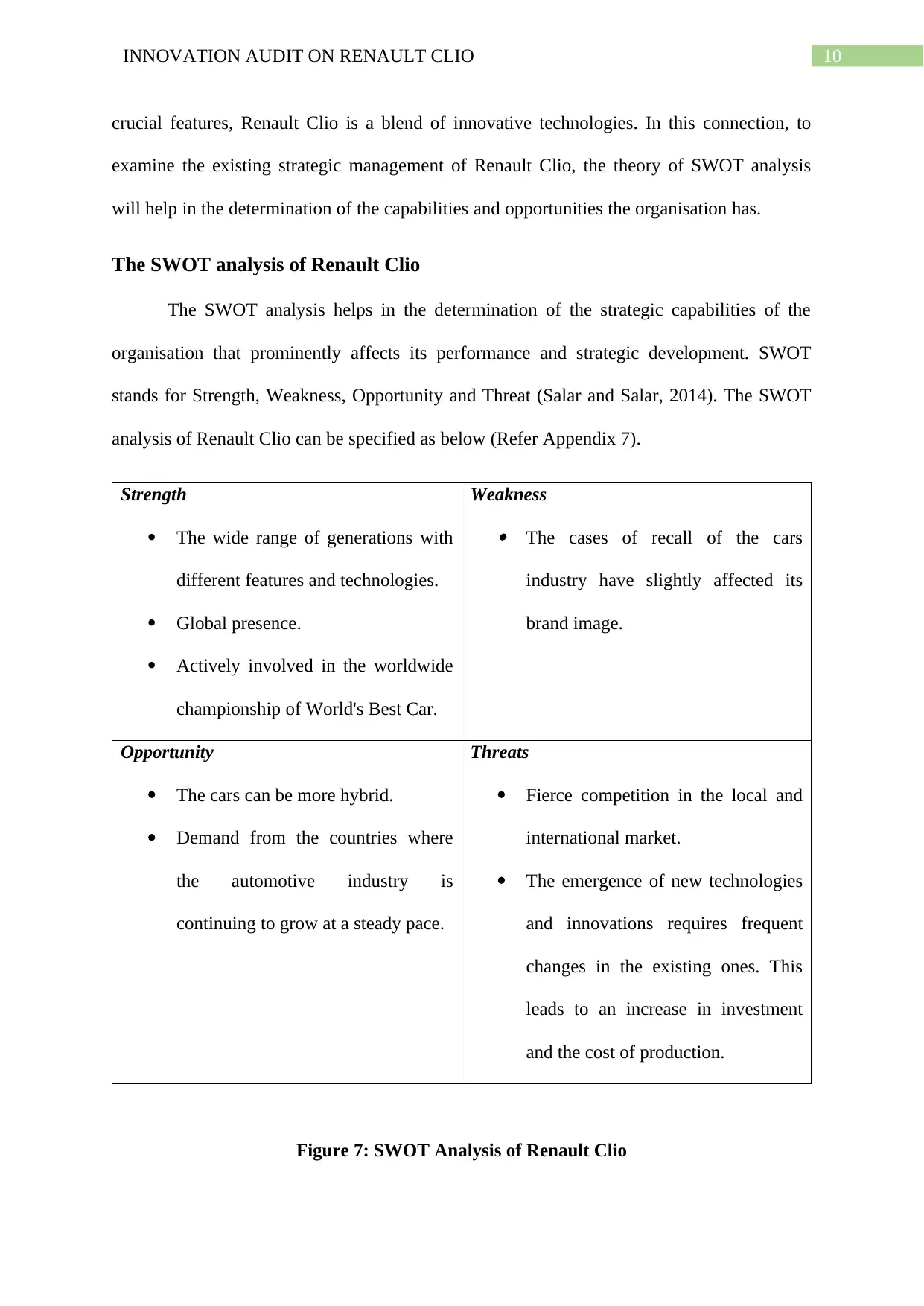
10INNOVATION AUDIT ON RENAULT CLIO
crucial features, Renault Clio is a blend of innovative technologies. In this connection, to
examine the existing strategic management of Renault Clio, the theory of SWOT analysis
will help in the determination of the capabilities and opportunities the organisation has.
The SWOT analysis of Renault Clio
The SWOT analysis helps in the determination of the strategic capabilities of the
organisation that prominently affects its performance and strategic development. SWOT
stands for Strength, Weakness, Opportunity and Threat (Salar and Salar, 2014). The SWOT
analysis of Renault Clio can be specified as below (Refer Appendix 7).
Strength
The wide range of generations with
different features and technologies.
Global presence.
Actively involved in the worldwide
championship of World's Best Car.
Weakness
The cases of recall of the cars
industry have slightly affected its
brand image.
Opportunity
The cars can be more hybrid.
Demand from the countries where
the automotive industry is
continuing to grow at a steady pace.
Threats
Fierce competition in the local and
international market.
The emergence of new technologies
and innovations requires frequent
changes in the existing ones. This
leads to an increase in investment
and the cost of production.
Figure 7: SWOT Analysis of Renault Clio
crucial features, Renault Clio is a blend of innovative technologies. In this connection, to
examine the existing strategic management of Renault Clio, the theory of SWOT analysis
will help in the determination of the capabilities and opportunities the organisation has.
The SWOT analysis of Renault Clio
The SWOT analysis helps in the determination of the strategic capabilities of the
organisation that prominently affects its performance and strategic development. SWOT
stands for Strength, Weakness, Opportunity and Threat (Salar and Salar, 2014). The SWOT
analysis of Renault Clio can be specified as below (Refer Appendix 7).
Strength
The wide range of generations with
different features and technologies.
Global presence.
Actively involved in the worldwide
championship of World's Best Car.
Weakness
The cases of recall of the cars
industry have slightly affected its
brand image.
Opportunity
The cars can be more hybrid.
Demand from the countries where
the automotive industry is
continuing to grow at a steady pace.
Threats
Fierce competition in the local and
international market.
The emergence of new technologies
and innovations requires frequent
changes in the existing ones. This
leads to an increase in investment
and the cost of production.
Figure 7: SWOT Analysis of Renault Clio
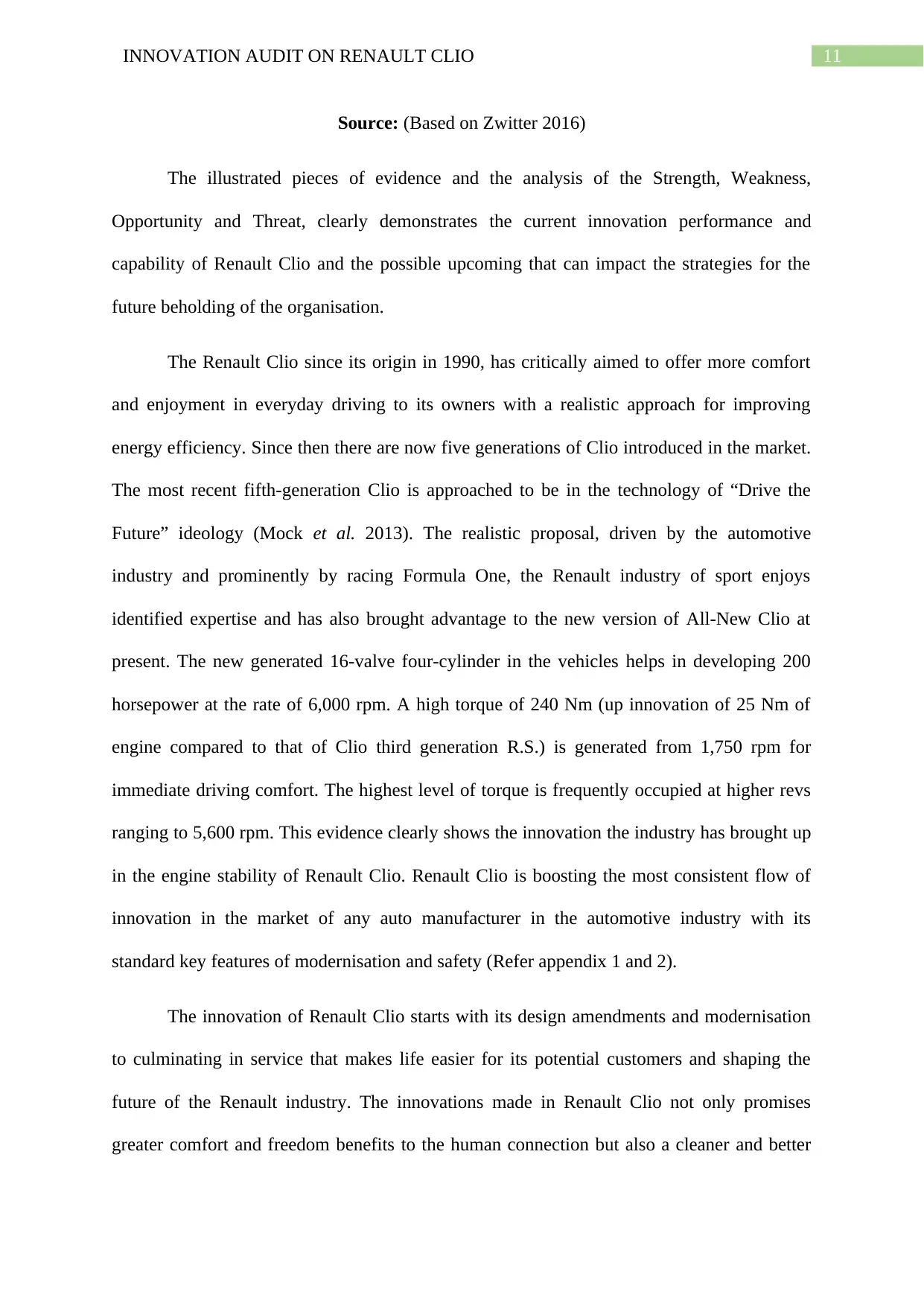
11INNOVATION AUDIT ON RENAULT CLIO
Source: (Based on Zwitter 2016)
The illustrated pieces of evidence and the analysis of the Strength, Weakness,
Opportunity and Threat, clearly demonstrates the current innovation performance and
capability of Renault Clio and the possible upcoming that can impact the strategies for the
future beholding of the organisation.
The Renault Clio since its origin in 1990, has critically aimed to offer more comfort
and enjoyment in everyday driving to its owners with a realistic approach for improving
energy efficiency. Since then there are now five generations of Clio introduced in the market.
The most recent fifth-generation Clio is approached to be in the technology of “Drive the
Future” ideology (Mock et al. 2013). The realistic proposal, driven by the automotive
industry and prominently by racing Formula One, the Renault industry of sport enjoys
identified expertise and has also brought advantage to the new version of All-New Clio at
present. The new generated 16-valve four-cylinder in the vehicles helps in developing 200
horsepower at the rate of 6,000 rpm. A high torque of 240 Nm (up innovation of 25 Nm of
engine compared to that of Clio third generation R.S.) is generated from 1,750 rpm for
immediate driving comfort. The highest level of torque is frequently occupied at higher revs
ranging to 5,600 rpm. This evidence clearly shows the innovation the industry has brought up
in the engine stability of Renault Clio. Renault Clio is boosting the most consistent flow of
innovation in the market of any auto manufacturer in the automotive industry with its
standard key features of modernisation and safety (Refer appendix 1 and 2).
The innovation of Renault Clio starts with its design amendments and modernisation
to culminating in service that makes life easier for its potential customers and shaping the
future of the Renault industry. The innovations made in Renault Clio not only promises
greater comfort and freedom benefits to the human connection but also a cleaner and better
Source: (Based on Zwitter 2016)
The illustrated pieces of evidence and the analysis of the Strength, Weakness,
Opportunity and Threat, clearly demonstrates the current innovation performance and
capability of Renault Clio and the possible upcoming that can impact the strategies for the
future beholding of the organisation.
The Renault Clio since its origin in 1990, has critically aimed to offer more comfort
and enjoyment in everyday driving to its owners with a realistic approach for improving
energy efficiency. Since then there are now five generations of Clio introduced in the market.
The most recent fifth-generation Clio is approached to be in the technology of “Drive the
Future” ideology (Mock et al. 2013). The realistic proposal, driven by the automotive
industry and prominently by racing Formula One, the Renault industry of sport enjoys
identified expertise and has also brought advantage to the new version of All-New Clio at
present. The new generated 16-valve four-cylinder in the vehicles helps in developing 200
horsepower at the rate of 6,000 rpm. A high torque of 240 Nm (up innovation of 25 Nm of
engine compared to that of Clio third generation R.S.) is generated from 1,750 rpm for
immediate driving comfort. The highest level of torque is frequently occupied at higher revs
ranging to 5,600 rpm. This evidence clearly shows the innovation the industry has brought up
in the engine stability of Renault Clio. Renault Clio is boosting the most consistent flow of
innovation in the market of any auto manufacturer in the automotive industry with its
standard key features of modernisation and safety (Refer appendix 1 and 2).
The innovation of Renault Clio starts with its design amendments and modernisation
to culminating in service that makes life easier for its potential customers and shaping the
future of the Renault industry. The innovations made in Renault Clio not only promises
greater comfort and freedom benefits to the human connection but also a cleaner and better
⊘ This is a preview!⊘
Do you want full access?
Subscribe today to unlock all pages.

Trusted by 1+ million students worldwide
1 out of 32
Related Documents
Your All-in-One AI-Powered Toolkit for Academic Success.
+13062052269
info@desklib.com
Available 24*7 on WhatsApp / Email
![[object Object]](/_next/static/media/star-bottom.7253800d.svg)
Unlock your academic potential
Copyright © 2020–2025 A2Z Services. All Rights Reserved. Developed and managed by ZUCOL.





